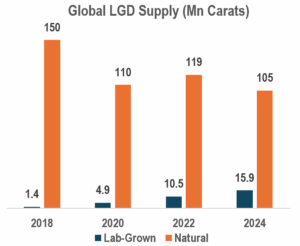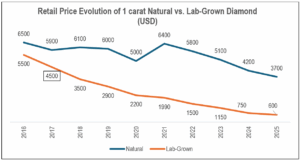What is Mined Diamond?
Diamonds begin their existence roughly 100 miles beneath the Earth’s surface, within the mantle. Over millions of years, intense heat and pressure fuse carbon atoms, transforming common carbon into the diamonds we know.
- Rarity of High Quality Diamonds: Not all diamonds share the same prestige. While abundant in nature, those truly captivating gems possessing exceptional clarity, colour, cut, and carat are exceedingly rare. These command premium prices.
- From Mine to Market: A Costly Journey: The journey from mine to market is long, complex, and expensive. Mining, cutting, polishing, and certifying all add up, contributing to the final price tag. Nine out of 10 natural diamonds globally are cut and polished in India, with the city of Surat playing a key role.
- Branding, Exclusivity & Price Control: A premium brand name on your diamond ring often translates to a hefty price tag.
What is Lab-Grown Diamond?
Lab-grown diamonds (LGDs) are diamonds manufactured through a man-made process. Diamonds per se are simply carbon molecules arranged in a specific crystal structure. LGDs are manufactured by taking carbon from a widely available source (graphite, methane, etc.) and treating it under specific conditions. LGDs have the same chemical composition as natural diamonds.
Two methods used to produce lab-grown diamonds
- High Pressure High Temperature (HPHT): HPHT is the more traditional method and relies on creating an extreme temperature-pressure environment using a mechanical press. In the HPHT technique, pressures of 5-6 GPa are required, increasing the cost.
- Chemical Vapour Deposition (CVD): CVD was commercialized more recently, in the 2000s. Unlike HPHT, CVD uses a microwave plasma chamber, coupled with a vacuum. The entire set-up is called a reactor, which is less expensive compared to HPHT. CVD has emerged as a preferred technique to create affordable lab-grown diamonds.
From 2000 to 2010, most CVD-grown diamonds submitted to GIA were under half a carat. Today, the majority of them exceed 3 ct. Some HPHT-grown diamonds surpass 100 carats in size. The largest recorded laboratory-grown diamond is a 150.42 ct HPHT-grown crystal with good quality, created in November 2021. The Koh-i-Noor is one of the largest cut natural diamonds in the world, weighing 105.6 carats (21.12 g)
(Source: https://www.gia.edu/gia-news-research/gems-gemology-summary-latest-research-lab-grown-diamonds)
Global market Size of LGD

Source:Jefferies, Wazir Analysis.
- US is by far the largest market for lab-grown diamonds, accounting for >75% of global volumes. In the US, LGD usage has been predominantly in engagement rings. In fact, LGD now has a 10% share in diamond engagement rings market in the US vs. <3% two years ago.
- LGD supply has surged over 10x in six years, fuelled by technological advancements, lower entry barriers, and declining reactor costs.
Unlocking Price: Lab-Grown vs. Mined Diamonds
The price of a diamond is primarily determined by the “4 Cs”
- Carat: Refers to the weight of the diamond. Larger diamonds are generally more expensive, and the price increases exponentially with carat size.
- Colour: Diamonds are graded on a scale from D (colourless) to Z (noticeable colour tint). The less colour, the higher the price.
- Clarity: Refers to the presence of internal (inclusions) or external (blemishes) flaws. Fewer imperfection lead to higher prices
- Cut: A well-cut diamond will maximize brilliance and sparkle, even if other factors are similar. A poorly cut diamond can appear dull, even if it has a high carat weight and good colour/clarity.
Additionally, Shape, Certification, market demand, supply, and global economic conditions also play a significant role.

Source:https://wazir.in/wp-content/uploads/2025/03/Lab-Grown-Diamond_Though-Paper.pdf
Though lab-grown diamond technology has existed for decades, its jewellery adoption was limited until the last decade. This surge is fuelled by two factors:
- Improving quality and a 90% reduction in production costs since 2008, largely due to CVD technology.
- Consequently, lab-grown diamond prices have plummeted over 70% since 2016, making them far more accessible to consumers.
Prices of Lab Grown and Natural diamonds based on Carats:
| Round-G-VS2-GIA Certified |
Earth Mined |
Lab-Grown |
| 1 Carat |
$4,000 |
$1,100 |
| 2 Carat |
$18,000 |
$2,500 |
| 3 Carat |
$40,000 |
$3,000 |
| 4 Carat |
$75,000 |
$4,000 |
| 5 Carat |
$1,20,000 |
$6,000 |
Source:https://www.diamondmansion.com/blog/lab-grown-diamonds-vs-natural/
How can one differentiate a lab grown diamond from a natural diamond?
Telling a lab-grown diamond from a natural diamond by eye is impossible, even for experienced jewellers, because their chemical and physical properties are identical. However, specialized lab equipment can detect their unique origins. For instance, natural diamonds typically contain minute traces of nitrogen, whereas most lab-grown diamonds lack nitrogen or have different nitrogen configurations due to their controlled growth.
HDFC Tru is the Investment Advisory arm of HDFC Securities Ltd; SEBI Registration No: INA000011538. Website: www.hdfc-tru.com, Email: tru@hdfcsec.com, Phone: +91 993020394


